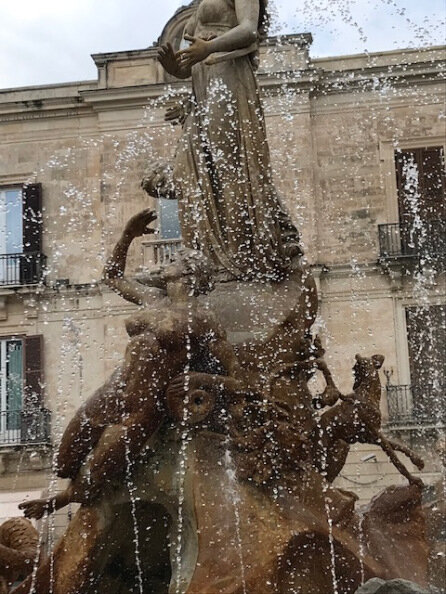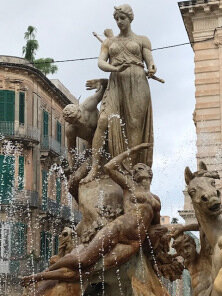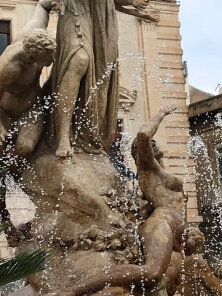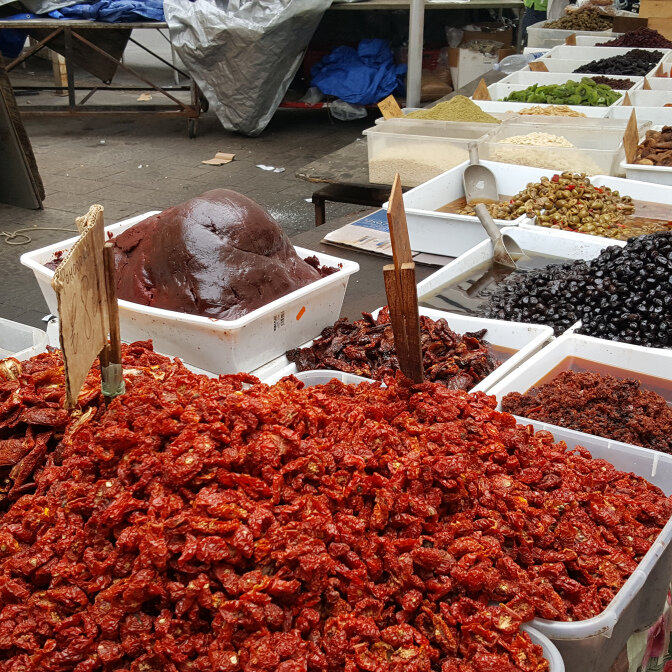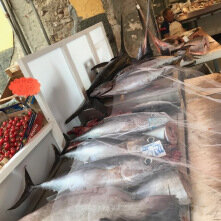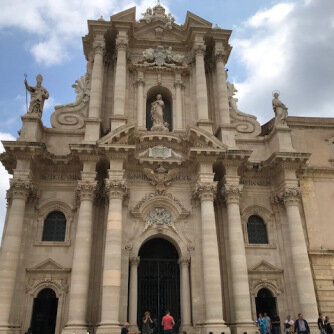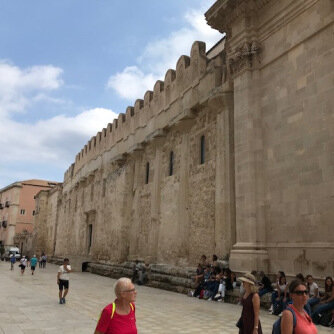Siracusa
Ciao Tutti!!
Today was our first full day in Syracuse Sicily. As I had noted yesterday, I am very excited to be here. This morning, much to the chagrin of my son, we got a bright an early start. There is just too much to see in this wonderful place in just one short day. So, after a quick Italian breakfast, we were on our way. I should note that the breakfasts here are quite different. They have a buffet with a spread of a wide variety of items, lot of cheese and meats. There is also a good stock o delicious fruit. The fruit and vegetables here are incredible. If you are doing a keto diet this is the place or you. There is, of course, some pastry and you could get a cappuccino, but I love the wide variety of cheeses.
Our ultimate destination was the Occhio di Dionisio (Ear of Dionysius) which is a limestone cave. Along the way, we stopped at a number of points of interest for which the city is well known.
Our first stop was the Fonte Arethua . What makes this of interest is that the fountain starts in a freshwater spring. The spring, in addition to being the home of aquatic life, is festooned with the only natural Papyrus (Papireto) in Europe. The Fonte is named after the nymph, Arethusa.
Fonte Arethusa
Those of you who are fans of Greek mythology may be familiar with the legend of Arethusa. (Fair warning, the names in this story are very similar so this may get confusing.) You see, Arethusa was an attendant to the goddess Artemis. According to Ovid, Arethusa while wondering about came to a clear stream whose waters were so inviting that she began bathing. As she was relaxing, she was seen by the river god Alpheus whose river this stream happened to be part. Nymphs were pretty hot, so it is not a surprise that Alpheus the river god fell in love with her. This happens a lot in Greek mythology. There is always some god someplace with “love” on his mind.
Unfortunately, for both Arethusa (the nymph) and Alpheus (the river god) when you are an attendant to Artemis (the goddess of the hunt and chastity) you have to maintain your “purity”, so she ran. Alpheus (the river god) was persistent; he was not about to give up. So, Arethusa (the nymph) prayed to Artemis (the goddess) for help. So the goddess veiled the distressed nymph in a cloud, but Alpheus still did not give up. The nymph was so frightened that she began to perspire from fear so profusely that she turned into a stream. Artemis then broke the ground to allow Arethusa to escape. The stream traveled under the sea to the island of Ortygia. Still the river god didn’t give up!! This guy had it bad. He flowed through the sea to get at her and mingle his waters with his. There is an interesting metaphor. So this is the spot I gather where she came to the surface.
Later in the day, as we headed back to our hotel, we saw the fountain Fonta di Diana which is dedicated to the goddess Diana in the Piazza di Archimede. As shown in the pictures it is a beautiful fountain in which we see the river God Alpheus, peaking around the Goddess to catch a glimpse of Arethusa. One of the many things I love of Italy is the fountains. This particular fountain brings the story of Arethusa to life. You can see the river god, hell-bent on getting at the poor nymph. You can see Diana standing between the two, the nymph’s protector.
Although she is not terribly well known, I like Arethusa. When Demeter was searching for her daughter Persephone, Arethusa implored Demeter to end her punishment of Sicily. Arethusa told her that she had seen Persephone as the queen of Hades, but that is another story I haven’t the time to discuss today.
As hoped we did make it to the Ear of Dionysius. When someone asked me why it was called The Ear of Dionysius, I explained to them that it is to honor the man who was the inventor of the Q-Tip. He did not think it was as funny as I. The actual legend is the Dionysius was supposedly a tyrant who would imprison people in these limestone caves. The acoustics were such in the cave that the guards could overhear any whispered secret plans. I will acknowledge that the acoustics were quite good. As we entered the cave we could hear a tour guide singing Va Pensiero.
The Ear of Dionysius
The Ear of Dionysius is part of what is known as Latomia Del Paradiso. Latomia meaning quarries. These quarries were used throughout history for various purposes. At times they were used as prisons as referenced above and at other times as catacombs. Today they are surrounded by gardens. It was actually quite nice to walk about the gardens in the heat of days, to wander down the tree covered paths.
There were also two more sights worth noting as we wandered back to our hotel. The first was Ortygia market. Oh my gosh, the sights and sounds of the place. If I lived here this is where I would get my food. There were tons of fresh fish of just about every variety. Although come to think of it, I didn’t see any eel. We did see a lot of calamari. Not sure I want to think of that when I am eating dinner this evening.
The market is a sensory explosion. The colors of the fresh fruit, spices, and vegetables were dazzling. We passed a stall selling spices with a large pile of dried peppers of the most vibrant red I had ever seen. As we walked along one vendor would start to sing out, when he finished another would take up the song from across the street or further down. It was as if they were singing to one another. Then there were the smells. You could imagine the smell of the fish, but it was the smell of the cheese that is most memorable. They say the French have stinky cheese. I have not smelled anything in France like what I experienced at the market. It was the sharp earthy smell of real aged cheese, not the machine-made nonsense that is regurgitated from factories, but real cheese fresh from nearby farms.
Finally, there is the Piazza Del Domo. My son reminded me that this piazza is featured in the film Malena with Monica Bellucci. The Domo itself is so representative of Sicily’s history. It was once a Greek temple that had been converted into a Catholic Cathedral. As you stand in front of its walls you can see the history of Sicily. There are the Greek Columns where the spaces between them had been filled in by the Christians. The wall is crowned with a Norman parapet.
As we stood looking that Domo, a wedding party arrived to take pictures. The bride and groom looked so happy. At one point, the groom had wandered away from the bride as he talked with some other members of the party. The bride looked around but not see the groom at her side. Turning she called to him; “HEY!! Mio Marito!” Hiking up her dress she ran the ten-foot space that separated them and jumped into his arms. They kissed with closed eyes, eyes that were closed to the world around them. IT was just the two of them holding each other in a loving embrace.
That little scene brought me back 32 years when I was the groom. I remember my own bride telling me that she speaking with someone and she used the phrase “my husband” for the first time. Being able to say that “my husband” stood out as symbolic of a turning point in life. When I heard that young bride say “mio marito”, my husband, I believe that she was reveling in the feeling. It makes me miss not having my own bride here with me.
So this is Sicily. Rich in history dating back to the Greek colonies, but alive today, vibrant with life and love.
Ciao Tutti!!!!


